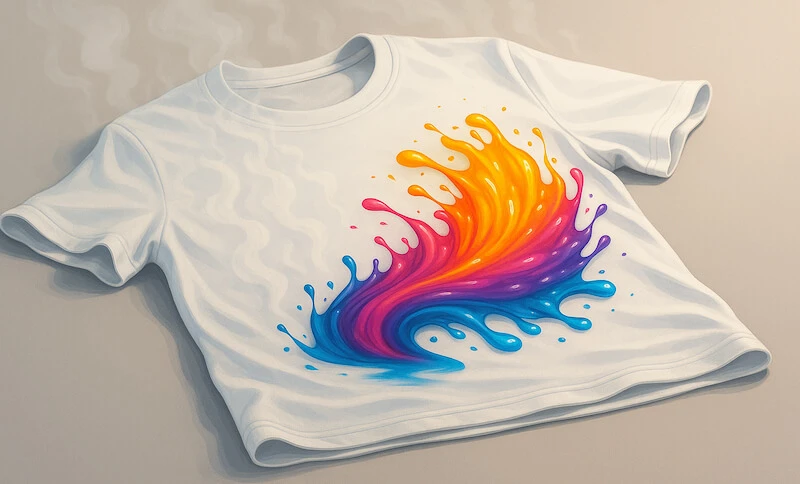Ever noticed that sublimated prints sometimes look dull right after pressing, but then sharpen and deepen once they cool? That’s not just visual perception. The cooling phase plays a critical chemical role in locking dye molecules into the polymer structure of polyester. If you rush that process with forced cooling (like fans, cold surfaces, or removing transfer paper too soon), you interfere with dye stabilization. That’s when fading, shifting colors, or blurry edges can occur.
Why Ink Particle Size Affects Sharpness and Color SaturationSublimation inks are engineered with micro-fine dye particles. Smaller particles flow easily through printheads and form tighter, more controlled dot patterns on the transfer paper. This reduces overspray and bleeding, resulting in cleaner edges. During heat pressing, fine particles fully convert into gas and penetrate polyester fibers more evenly, creating deeper color saturation. Larger or inconsistent particles vaporize unevenly, leading to dull color, fuzzy edges, and clogging.

During sublimation, the dye becomes vapor and penetrates polyester while heat expands the polymer chains. As the item cools, those chains begin tightening back to their original structure, capturing the dye molecules inside the fiber. This bonding process is covered in our guide on how polyester bonds with sublimation dye, offering additional context on polymer behavior.
Natural cooling allows this contraction to occur gradually, giving the dye time to transition back from vapor to solid within the fiber itself. Forced cooling, however, shocks the polymer structure. When a fan, cold surface, or rapid temperature drop forces the fibers to contract too quickly, the polymer chains can close unevenly. In that moment, dye molecules that have not yet fully solidified may remain mobile, shifting position or rising back toward the surface. This produces inconsistent color density, reduced vibrancy, or edge blur.
Rapid cooling can also create micro-condensation on the surface of the item, which interferes with dye settling and causes a slightly washed-out appearance. By allowing the substrate to cool naturally, the dye has enough time to crystallize evenly inside the polyester, locking in deeper saturation, sharper edges, and long-term color stability.
| 💡 Micro-condensation refers to very tiny droplets of moisture that form on a surface when there is a rapid change in temperature — specifically, when a warm object suddenly comes into contact with cooler air or a cooler surface. |
Key Takeaways
Dye placement is still fluid after pressing.
The color you see immediately after removing the heat isn’t final, the dye molecules are still moving within the polyester while the material cools.
Forced cooling freezes dye mid-transition.
Rapid temperature drops can trap the dye before it reaches the deepest layer of the fiber, resulting in weaker saturation.
Uneven cooling = uneven color.
Areas that cool faster (from airflow, touching the surface, or lifting transfer paper early) can lock dye at different depths, creating patchiness or haze.
The substrate also needs time to stabilize.
Polyester naturally contracts as it cools. If the cooling happens too fast, the fibers can tighten unevenly, creating tiny variations in fiber alignment. These micro-shifts change how light reflects off the surface, which can make colors appear slightly dull, soft, or hazy.
Dye Placement Is Still Fluid After Pressing
Immediately after you lift the heat press, dye mobility is still high. The sublimation dye is in a vapor-phase, and its movement—called dye diffusion, dye migration, or sublimation gas flow—continues for several seconds as the substrate begins to cool. This post-press dye behavior means the color you see right away is not final.
During this period, molecular motion remains active because of residual heat effects. The polyester fibers are still expanded from heat, which allows ongoing polymer–dye interaction. As the temperature slowly drops, the vapor dye transitions back toward a solid state, a process tied to the cooling phase transition.
This is when color settling and dye stabilization occur. The dye moves deeper into the fiber structure, reaching its intended dye absorption depth. If this process is interrupted or rushed, a color shift during cooling can happen, leading to reduced saturation or uneven tone.
In short: dye continues to move and stabilize after pressing. Natural cooling ensures it reaches the correct depth and locks in properly.
Rapid Cooling Locks the Dye Before It Can Fully Set
When the item experiences forced cooling—from fans, cooling plates, cold surfaces, or by removing transfer paper too early, the dye begins to solidify too fast. This accelerated temperature drop creates shock cooling or flash cooling, stopping the dye before it reaches its intended depth.
This abrupt shift causes premature dye locking, where the dye becomes fixed in place during unfinished dye solidification. Instead of sinking deeper, the color can stall near the surface, leading to shallow dye absorption, surface-level dye settling, and incomplete dye penetration.
Because the polyester contracts quickly during cooling, this can also trigger rapid contraction, which traps dye in the wrong location. The result is dye trapping, color freezing, and interrupted stabilization, all of which reduce final saturation and clarity once the item reaches room temperature.
Polyester Needs Time to Contract and Stabilize During Cooling
Polyester remains structurally unstable immediately after pressing. The heat keeps the fibers expanded, and the material enters a natural cooling cycle where polymer relaxation and fiber contraction occur. If this phase happens too quickly, the fibers don’t have time to complete polymer chain reformation, leading to uneven cooling-induced polymer tightening.
| 💡 What Happens to Polyester if it Cools Too Quickly After Sublimation?Rapid cooling causes uneven fiber contraction, which can make the polyester look dull, hazy, or slightly distorted. Colors may appear patchy and fine details can lose sharpness. |
Controlled cooling lets the substrate reach material equilibrium. This steady temperature drop supports consistent fiber alignment, predictable fiber realignment, and reliable structural stabilization. As the polyester settles, crystalline structure formation strengthens the surface and restores substrate integrity.
When polyester is allowed to cool naturally, the substrate stabilizes evenly. When cooling is forced, the fibers contract at different rates, introducing slight distortions that affect how the final color appears on the surface.
What Else Can Inconsistent Cooling Lead To?
Inconsistent cooling creates temperature differences across the surface, which affects how the final color develops. These variations can cause patchy saturation, uneven tone formation, blotching, banding, or micro-haze as different areas cool and set at different speeds. Fine details may also lose clarity, with softening, minor ghosting, or inconsistent density in areas where the dye solidified at the wrong moment.
Beyond visual precision, uneven cooling also influences how securely the dye bonds inside the polyester. When parts of the print experience incomplete dye penetration or shallow settling, those areas become less stable over time. This can lead to faster fading, weaker abrasion resistance, and reduced wash durability, because the dye wasn’t fully locked into the fiber structure before the cooling cycle finished. Over time, these weak points may show early wear or surface erosion, making the design lose vibrancy sooner even though sublimation itself does not peel.
Related Topics
